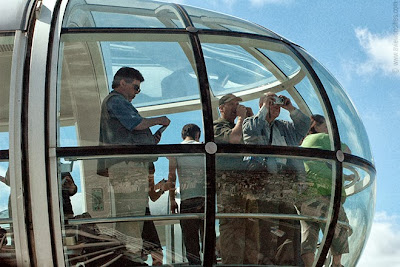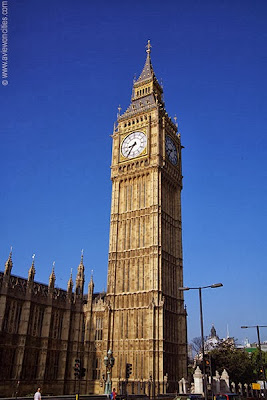The Louvre, originally a royal palace but now the
world's most famous museum, is a must-visit for anyone with a slight
interest in art. Some of the museum's most celebrated works of art
include the Mona Lisa and the Venus of Milo.
The Louvre Museum is one of the largest and most important museums in
the world. It is housed in the expansive Louvre Palace, situated in the
1st arrondissement, at the heart of Paris.
Louvre Museum
The collection of the Louvre Museum was first established in the 16th
century as the private collection of King Francis I. One of the works of
art he purchased was the now famous Mona Lisa painting. The collection
grew steadily thanks to donations and purchases by the kings. In 1793,
during the French Revolution, the Louvre became a national art museum
and the private royal collection opened to the public.
Louvre Interior
The museum has a collection of over 1 million works of art, of which
about 35 000 are on display, spread out over three wings of the former
palace. The museum has a diverse collection ranging from the Antiquity
up to the mid 19th century.
Venus of Milo
Some of the most famous works of art in the museum are the Venus of
Milo, the Nike of Samothrake, the Dying Slave by Michelangelo and of
course Leonardo da Vinci's Mona Lisa.
After entering the museum through the Louvre Pyramid
or via the Carrousel du Louvre, you have access to three large wings:
Sully, Richelieu and Denon. Below a brief description of the highlights
in each wing.
Sully Wing
The Sully wing is the oldest part of the Louvre. The second floor
holds a collection of French paintings, drawings and prints. One of the
highlights is the erotic Turkish Bath, painted in the late 18th century
by Jean-Auguste-Dominique Ingres.
The first and ground floors of the Sully wing display works from the
enormous collection of antiquities. In the 30 rooms with Egyptian
antiquities you find artifacts and sculptures from Ancient Egypt such as
the famous Seated Scribe and a colossal statue of Pharaoh Ramesses II.
On the ground floor is the statue of Aphrodite, better known as the
'Venus of Milo', one of the highlights of the Louvre's Greek collection.
For something completely different, you can go to the Lower Ground Floor
of the Sully wing where you can see some remnants of the medieval
castle of the Louvre.
Richelieu Wing

Paintings from the Middle Ages up to the 19th century from across
Europe are on the second floor of the Richelieu wing, including many
works from master painters such as Rubens and Rembrandt. Some of the
most notable works are the Lacemaker from Jan Vermeer and the Virgin of
Chancellor Rolin, a 15th century work by the Flemish painter Jan van
Eyck. The first floor of the Richelieu wing houses a collection of
decorative arts, with objects such as clocks, furniture, china and
tapestries.
On the same floor are the sumptuously decorated Napoleon III Apartments.
They give you an idea of what the Louvre interior looked like when it
was still in use as a royal palace.

The ground and lower ground floor are home to the Louvre's extensive
collection of sculptures. They are arranged around two glass covered
courtyards: Cour Puget and Cour Marly. The latter houses the Horses of
Marly, large marble sculptures created in the 18th century by Guillaume
Coustou. Nearby is the Tomb of Philippe Pot, supported by eight
Pleurants ('weepers').
The ground floor also houses a collection of antiquities from the Near
East. The main attraction here is the Code of Hammurabi, a large basalt
stele from the 18th century BC, inscribed with the Babylonian law code.
Denon Wing
Mona Lisa
The Denon Wing is the most crowded of the three wings of the Louvre
Museum; the Mona Lisa, a portrait of a woman by Leonardo da Vinci on the
first floor is the biggest crowd puller. There are other masterpieces
however, including the Wedding Feast at Cana from Veronese and the
Consecration of Emperor Napoleon I by Jacques Louis David. Another star
attraction of the museum is the Winged Victory of Samothrace, a Greek
marble statue displayed at a prominent spot in the atrium connecting the
Denon wing with the Sully wing.
The ground floor of the Denon wing houses the museum's large collection
of Roman and Etruscan antiquities as well as a collection of sculptures
from the Renaissance to the 19th century. Here you find Antonio Canova's
marble statue of Psyche Revived by Cupid's Kiss. Even more famous is
Michelangelo's Dying Slave. On the same floor are eight rooms with
artifacts from Africa, Asia, Oceania and the Americas. Medieval
sculptures from Europe are displayed on the lower ground floor of the
Denon wing.

Winged Victory
History of the Louvre Palace
The Louvre in the 15th century
Louvre seen from across
the Seine
Richelieu Wing
The Louvre was created in several phases. Originally built as a 12th
century fortress by King Philip II, it was significantly expanded in the
14th century during the reign of King Charles V.
Its current palatial appearance goes back to the late 15th century, when
the original fortress was demolished and the wing along the Seine river
was built. The palace was extended during the 16th century by architect
Pierre Lescot, who expanded the palace into a complex with two
courtyards. A decade later Catharina de Medici added the Tuileries
Palace to the west of the Louvre. Construction on the Louvre was halted
for some time when king Louis XIV decided to move to the Versailles Palace.
In the 19th century, during the Second Empire, the Louvre was expanded
again with the addition of the Richelieu wing. The wings were extended
even further westward during the Third Empire. The Louvre now had four
symmetric wings surrounding a large courtyard. This would not last long,
as the Communards burned the Tuileries Palace to the ground in 1871,
opening up the west side of the palace.
Louvre Pyramid
The most recent addition to the Louvre was the construction of the Louvre Pyramid,
which functions as the museum's main entrance. The pyramid was built in
1989 by the renowned American architect I.M. Pei. The glass pyramid
allows the sunlight to enter the underground floor.
The modern addition originally received mixed reviews, as it contrasts
sharply with the classical design of the surrounding buildings, but
today it is generally accepted as a clever solution which has given the
museum a spacious central entrance without the need to touch the
historic patrimony.










































